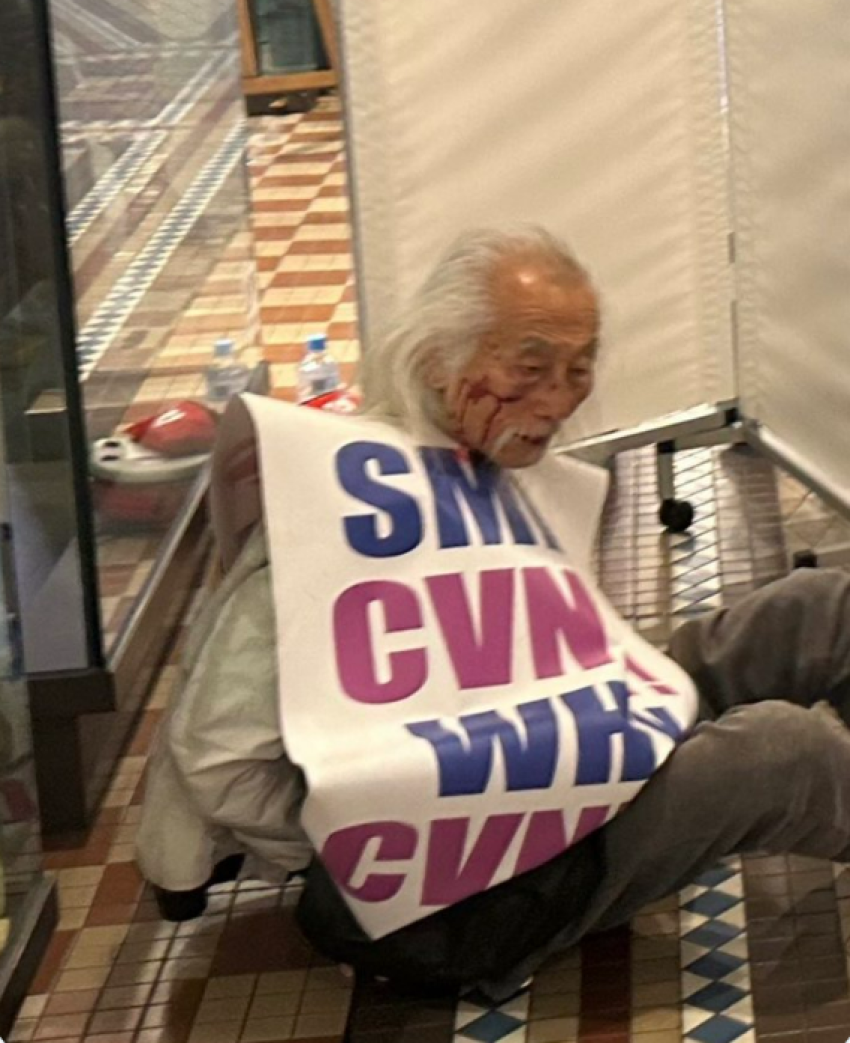
He’s beloved around the Sydney CBD for his cheeky but peaceful protests. But Danny Lim was in a “poor state” in hospital after sustaining injuries during a violent arrest by New South Wales Police on November 22.
78-year old Lim is a Sydney icon. He was wearing his trademark sandwich board sign — “SMILE CVN’T! WHY CVN’T?” — when police confronted him.
He was arrested for a similar sign past and went to court for alleged offensive conduct, but the court confirmed wearing such a sign is not against the law.
In fact, the use of more force than necessary is considered an assault under the law, and given the state of Lim after the incident, the conduct of police likely amounts to the crime of assault occasioning actual bodily harm.
The incident happened after police were called to the Queen Victoria Building by security guards shortly before 11am. Two police grabbed Lim, shoved him to the ground face first and handcuffed him as he lay vulnerable.
In the footage, a witness can be heard gasping in shock at the police actions. Lim is slightly built and is an elderly man. He could have been, and should have been, treated with more care, especially given the law makes clear police are allowed to use no more force than reasonably necessary during an arrest.
Failure to follow ‘move on’ direction
New South Wales Police said Lim declined to leave “when asked”. “Police will allege the man was subsequently issued with a move-on direction by officers and failed to comply,” NSW Police said.
“The man’s arrest was discontinued after he struggled with police and sustained an injury to his cheekbone.”
In the footage, passers-by can be heard gasping at Lim’s injuries and his blood on the tiled floor. Lim may have neck injuries and internal skill damage.
Police have promised to review body cam footage of the officers involved in the arrest and undertake a review. When can we begin to expect that officers will be appropriately trained when arresting people?
Lim is known to police as he was arrested in 2017 and 2019. Both times, as in this case, he posed no threat to armed police officers.
Lim was successful in the courts on both occasions over charges that his sign was “offensive”. The magistrate in 2019 was highly critical of the police officers’ behaviour.
Similar kinds of police misconduct issues are in the spotlight in Queensland, following a recent Commission of Inquiry which delivered a scathing report into the “broken system” and a “failure of leadership” over many years. The Queensland government has pledged $100 million towards reforms.
No appetite for real change
The New South Wales government, on the other hand, has so far lacked the appetite to investigate police behaviour in any meaningful way, despite the escalating concern.
Despite promises by Karen Webb, the new Police Commissioner, who outlined in her initial media conference a vision for “better and more connected community and workforce,” little seems to have changed.
Most preschool and primary school children are taught that police officers are a source of safety – a “go to” should they ever find themselves in trouble and without a grown-up they know.
Police also take an oath to “serve and protect” but increasingly the reality is quite different. Police officers in NSW have become a source of fear because there is just no way to predict how or when they might use weaponry or excessive force that seems vastly unjustified.
When Channel Seven posted the video footage of Lim’s arrest, it pre-warned viewers that some might find the content “distressing or confronting”.
Is this the new normal?
Time and again, officers who cause harm are not held accountable and are still paid to patrol the streets, leading them to be branded “thugs in uniform”.
NSW Greens’ police spokesperson Sue Higginson is demanding an independent investigation. “You can’t have police investigating police,” she said. “Not having an independent investigation into this is completely what the NSW police state looks like.”
Under section 199 of the Law Enforcement (Powers and Responsibilities) Act 2002 (NSW), it is an offence for a person to refuse or fail to comply with a direction given by a police officer without a reasonable excuse.
The section reads as follows:
“Failure to comply with police direction
“(1) A person must not, without reasonable excuse, refuse or fail to comply with a direction given in accordance with this Part.”
“Maximum penalty — 2 penalty units.
“(2) A person is not guilty of an offence under this section unless it is established that the person persisted, after the direction concerned was given, to engage in the relevant conduct or any other relevant conduct.”
A penalty unit in NSW is currently $110, which means the offence is publishable by a fine of up to $220.
[This article was first published by Sydney Criminal Lawyers and is reprinted with permission.]